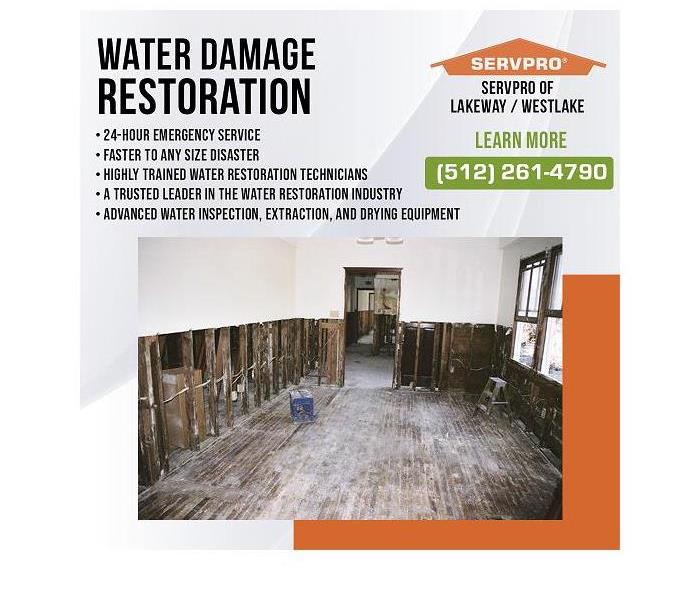The Drying Process in Water Damage Restoration: Why It Matters and How It Works
2/23/2021 (Permalink)
Blog Summary: The professionals at SERVPRO of Lakeway / Westlake discuss the water damage restoration drying process, its purpose, and its benefits.
Whether a property has leaky plumbing, a flood, or high humidity levels, drying the interior is necessary to reduce the potential for water damage and mold growth. Ideally, water damage restoration should begin within 48 hours of water exposure, but flood cleanup and water removal alone aren’t enough. For the best results, the building needs to be entirely dry.
SERVPRO of Lakeway / Westlake is a leading water restoration company in Bee Cave, Texas. Their certified restoration specialists understand the importance of effective drying, which they discuss below in further detail.
Importance of Drying During Water Damage Restoration
Drying is an essential step in the water damage restoration process as it minimizes water damage. Excess moisture in a structure can lead to:
- Mildew and unwanted odors
- Damage to personal belongings, such as clothing, furniture, and other items
- Wiring damage and metal surface corrosion, which may affect electronics and appliances
Damp, humid conditions can also encourage mold growth. It only takes about 24 to 48 hours for mold spores to multiply. Failure to adequately dry a property after water damage can result in further damage and the need for mold remediation services.
The Drying Process in Four Steps
- Water Extraction: The drying process begins with water extraction. Water damage professionals use several tools to remove water from the premises, including vacuum squeegees, shop vacs, and light wands for corners.
- Increase Airflow: After removing standing water, the restoration team will use high-velocity air movers to increase airflow and speed up the drying process.
- Dehumidifying: Large dehumidifiers will also aid in the drying process by removing excess moisture from the air and preventing other objects and structures in the room from absorbing moisture. Desiccant dehumidifiers that eliminate moisture with silica gel are highly effective for this stage in the process.
- Temperature Control: Maintaining the right temperatures will continue to allow moisture in a damp room to evaporate. Ideally, the temperature should be between 70 to 90 degrees F for the first 48 hours of the water restoration process. Temperatures lower than this will reduce evaporation, and hotter temperatures will decrease dehumidifier efficiency.
Benefits of Drying Before Water Damage Restoration
Perhaps the most significant benefit of taking the time to complete the drying stage properly is the decreased risk of mold growth.
High mold levels can cause health effects and considerable damage to porous materials like drywall, wood, and cloth. Since mold needs moisture to thrive, properly drying the premises will prevent future growth.
Proper drying also restores appropriate indoor humidity levels and allows the water damage restoration team to fully restore affected items like drapes, upholstery, and wood furniture.
Why SERVPRO?
As a top building restoration service in Bee Cave, Texas, SERVPRO of Lakeway / Westlake is a trusted water damage restoration provider. Their specialists are experts in advanced water inspections, water extractions, and property drying.
For professional residential or commercial water damage restoration services, call (512) 261-4790 or follow them on Facebook to learn more about water, mold, fire, and storm restoration.
Contact Information:
SERVPRO of Lakeway / Westlake
12600 Hill Country BLVD
Building - 5 Suite R-275
Bee Cave, TX 73738
https://www.SERVPROlakewaywestlake.com/

 24/7 Emergency Service
24/7 Emergency Service
